Evergreen Events: 5 Ways to Use Your On-Demand Content for Long-Term ROI

Table of Contents
Maximize Your Marketing ROI
Join 10,000 other marketers already getting the best tips on running engaging events that boost pipeline and create raving fans.
For 44% of event attendees, never having to miss a session is one of the biggest perks of a digital event. But sometimes, even if your event is virtual, attendees may miss out on valuable information — luckily, that’s where on-demand content comes to the rescue.
If you’re running a multi-track event, if an attendee has to pop out to take an important call, or if they have to miss the live event entirely due to other commitments — on-demand event content is here to keep the FOMO at bay.
With 84% of attendees reporting that access to on-demand content increases their viewing time, it’s no wonder event marketers are harnessing the power of this largely untapped demand-gen channel to provide viewers with the knowledge and experience they want.
So why the demand for on-demand? Let’s find out.
Here’s what we’ll cover:
- What is on-demand when it comes to B2B events?
- Does offering your event content on-demand really increase ROI?
- 5 ways to use your on-demand event content for long-term ROI
In the world of B2B events, what does on-demand content include?
First, let’s hit the basics. In the context of B2B events, on-demand content is anything you can download, stream, or consume that isn't live.
More specifically, on-demand content often refers to recorded video event footage that attendees can watch at a convenient time. But on-demand content could also include any supporting resources such as presentation slides, reports, templates, and more.
Today, a growing number of event marketers use on-demand event content to boost post-event engagement, increase reach, and forge even greater connections with existing prospects and audience members.
But your on-demand event content can do so much more — if you know how to use it to its full potential.
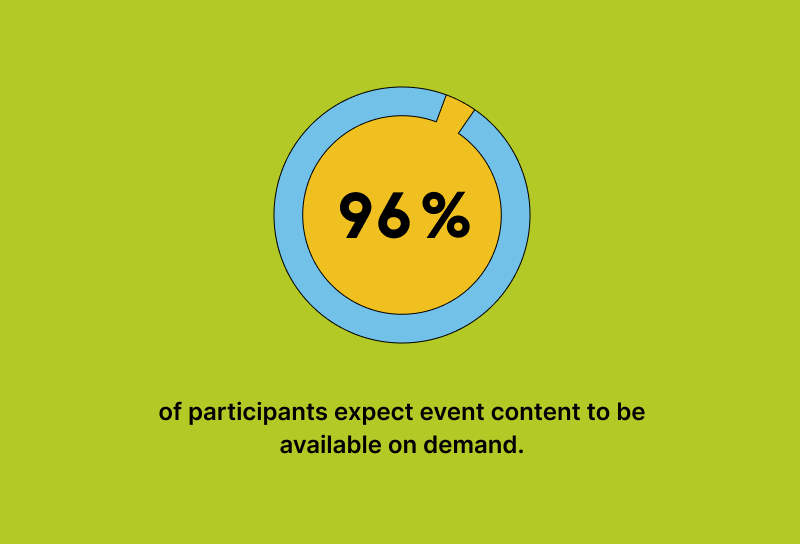
Does offering your event content on-demand really increase ROI?
At the end of the day, there’s only one question your boardroom really wants to know the answer to — how much revenue did the event generate?
If you’re already dipping your toes into on-demand content, you’re likely seeing some early return on investment (ROI) for your efforts via increased viewing time and engagement.
But on-demand content can do even more for your event bottom line by:
- Allowing your event to live on way past the closing keynotes.
- Boosting your lead gen efforts by attracting new, on-demand attendees.
- Expanding audience reach to those who would otherwise be unable to join (e.g., those in different timezones or with competing priorities).
- Improving accessibility via captioning and affordable pricing models for on-demand access.
- Making content easier to consume and digest with the ability to pause and replay.
- Repurposing event content for future promo material.
- Collecting data on those viewing your content even if they didn’t join live.
Here’s a quick example of exactly what this could mean in terms of event ROI.
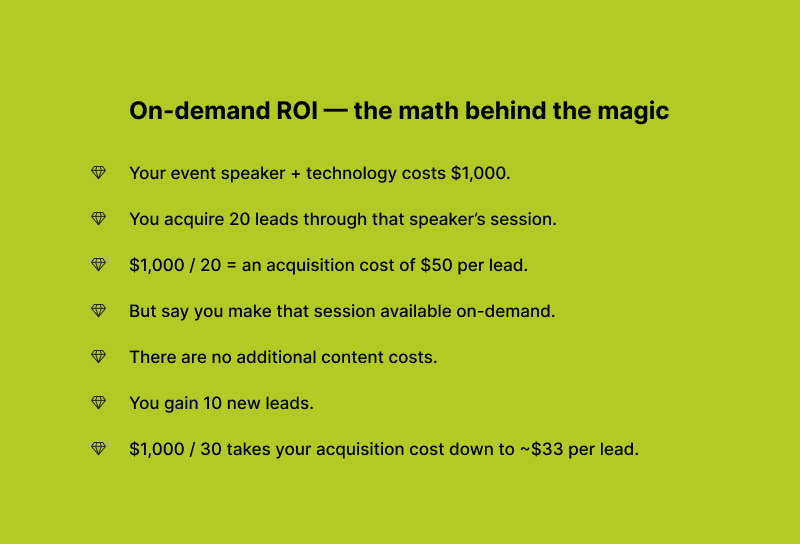
5 ways to use your on-demand event content for long-term ROI
#1. Send on-demand content as an event follow-up
Sales follow-ups post-event are crucial to achieving the pipeline results you’re looking for.
But for those follow-ups to pack a punch, they need to be personalized, relevant, and value-led — which is a fair amount to ask from a single email.
That’s where on-demand content comes in.
Using account-level insights garnered from your event, sales now has way more options for personalized follow-up.
Here are just a couple of quick examples for how it can be used:
- ‘We saw you watched our session on X topic, here’s a link to watch it again in case there’s anything you missed or would like a recap on.’
- ‘I know you didn’t get a chance to watch this session as you were already busy in the session on X, but we didn’t want you to miss out — here’s the session you couldn’t catch.’
- ‘We’re sorry you couldn’t make it to our event, we missed you! But don’t worry. If you’re still interested in the content, you can watch every session on demand.’
With this approach, recipients automatically know you’ve taken the time to review their attendee journey and understand what sessions they may want to access in order to tie the experience together.
Personalized. ✅ Relevant. ✅ Need-meeting. ✅
#2. Embed on-demand content into future blog articles
This is a trick we here at Goldcast use time and again when it comes to sharing on-demand content. Embedding your event session recordings helps bring organic blog content to life.
Second only to social media, adding videos to the company website or blog is deemed the most effective video promotion strategy. And with site visitors spending on average 1.4x more time on pages with video than without, it’s no wonder they’re a popular choice for anyone tasked with building brand awareness.
Here are just a few of our favorite ways to repurpose event content:
- Use the content as a tutorial or educational piece, backed up with written steps within your blog to make it extra-bookmarkable.
- Use your blog as a way to recap what was said in the session or provide additional analysis and thought leadership around a particularly hot or controversial topic.
- Highlight the key takeaways or share real experiences and examples from speakers and presenters who are applying the lessons learned for real results in their business.
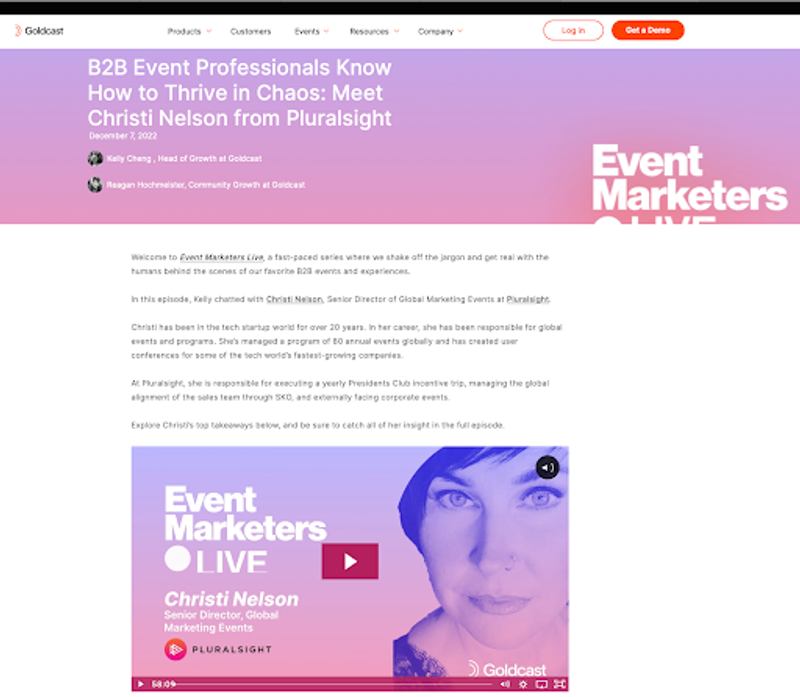
By embedding on-demand recordings of our Event Marketers Live series within our takeaways blog, we attract viewers who we otherwise may never have met!
#3. Gate on-demand content to drive leads via your website
Gated content can be a controversial topic for many modern marketers.
In case you’re new to the debate, gated content requires visitors to fill out a form before receiving access.
The information on this form can then be used for lead generation.
There are pros and cons associated with gating content, all of which require careful consideration:
- Generate leads
- Increase sales opportunities
- Simplify prospect segmentation
- Risk deterring people from consuming content
- Can reduce the number of page views
- No SEO benefit
To gate or not to gate, that is the question. Before you make your final decision, here are some key questions to consider:
- Is your content valuable enough to entice prospects to share their details?
- What stage of the funnel or customer journey is this content geared toward? Mid-to-bottom funnel content tends to perform better compared to gated top-of-funnel content.
- What are you going to do with the submission form data? Make sure you’re ready to nurture new leads as soon as the information is provided.
- Is this content unique? Or can prospects find it elsewhere without submitting their information? If they can, they will. In this case, failing to offer it for free could damage your brand.
#4. Create a library of on-demand content
Gating has its perks. But to truly drive evergreen ROI from your on-demand content, accessibility is crucial.
And to ensure as many people as possible are interacting on-demand, you need to create a place to house your content that is intuitive and easily located.
The answer? A one-stop-shop video content library. 🤩Sitting within your website, this dedicated area serves as a resource center for both prospects and clients, as well as an incredible Search Engine Optimization (SEO) tool to drive website traffic and build brand awareness.
But creating a stellar content library isn’t a simple task. Here are some tips to help get you started:
- Use content type filters: Your library doesn’t need to consist solely of on-demand videos. It can include blog content, ebooks, whitepapers, case studies, and more. Use filters to allow viewers to find their preferred formats quickly.
- Use topic categories: If your content covers a variety of topic areas, group them into five to seven core categories to help visitors filter quickly while encouraging them to explore a variety of content in their primary areas of interest.
- Provide a publishing date: This way, on-demand participants will know when your content was created and view it within the appropriate context.
- Use a title that speaks to the content: Set the right expectations by telling the reader exactly what’s in it for them when they choose to consume this content.
#5. Crop on-demand clips to share across channels
Every event generates hundreds of educational snippets — powerful statistics, inspiring quotes, step-by-step how-tos, tales from the industry battlefield… the list goes on.
Make these valuable insights available on-demand via a series of thought-provoking mini-lessons for your blog, social media, and other demand gen channels.
Better yet, live-stream your event across your social channels — YouTube, Facebook, LinkedIn, etc. — then save that stream to your profiles for others to find on-demand later.
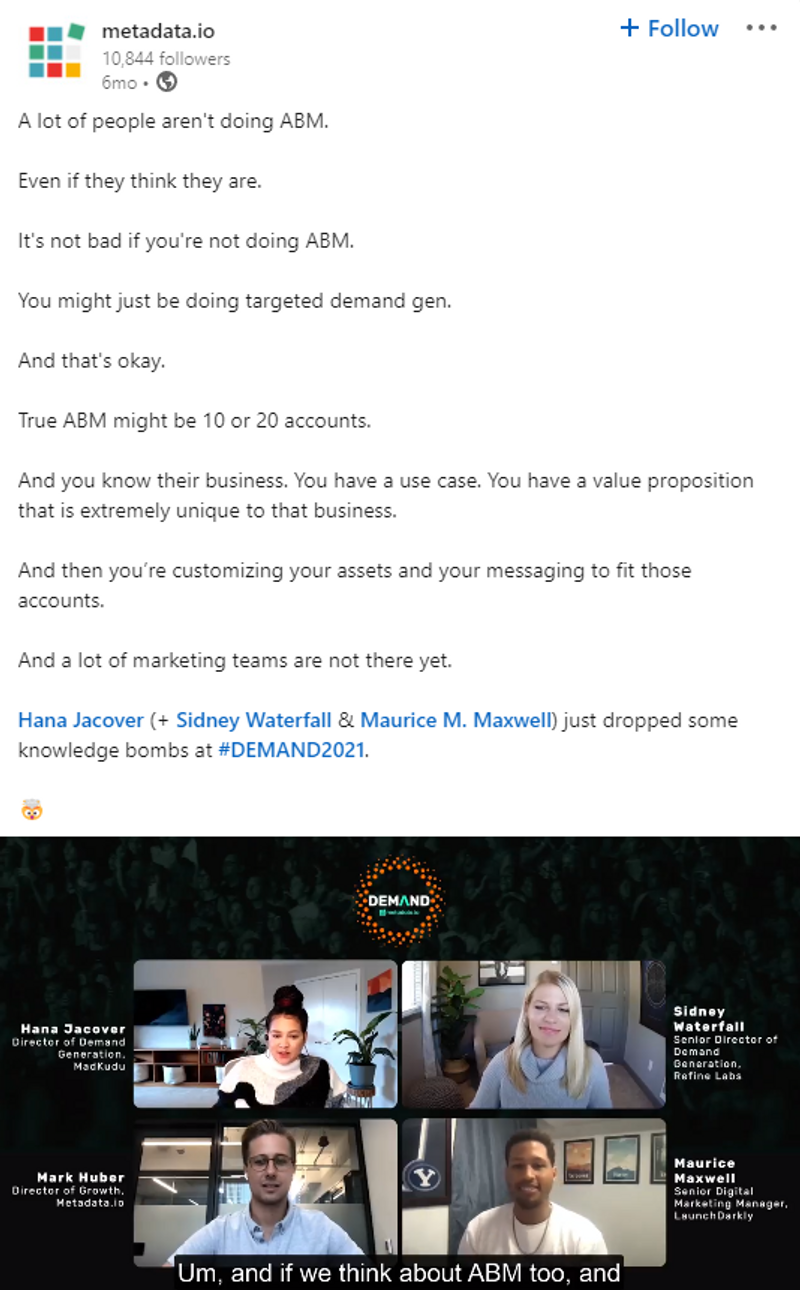
Check out how Metadata.io expertly repurposed snippets of their Demand2021 event to share as on-demand content on LinkedIn.
The tech features you’ll need to make on-demand happen
If you’re going to reap the rewards of on-demand, you’re going to need the right event technology to make it happen.
So what exactly should you look for? Let’s check out the essentials:
- Live content recording: Don’t overcomplicate things by outsourcing the recording element. Instead, look for a digital event platform that has high-quality recording built-in.
- On-demand viewing experience: While on-demand attendees may not have access to real-time engagement features like polls and Q&A, they should still be offered the best experience possible. With guided on-demand viewing options, your attendee can watch a Netflix-style on-demand show that allows them to sit back and enjoy without needing to navigate from one session to the next.
- On-demand viewing data: On-demand attendees are just as important as those watching live — which means the data you can harness from them is just as important too. Be sure your data grabs extend beyond your event to those accessing on-demand as well.
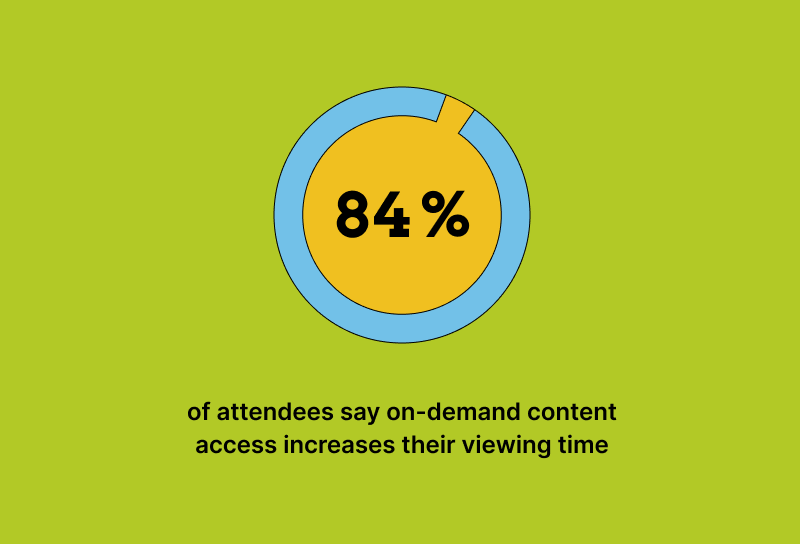
Meet the demand for on-demand
At Goldcast, we make it our mission to know what attendees want and need from their digital event experiences.
Whether it’s educating a brand new audience or keeping your existing customers close, making your event content available on-demand is a great way to drive evergreen demand and revenue for your organization.
And as we move forward into the future of event marketing, on-demand content will become a core expectation for your attendees. So give attendees what they really want with a robust digital event platform that does the on-demand prep work for you.

Transform Your Video Marketing with AI
Stay In Touch
Platform
Resources
© 2025 Copyright Goldcast, Inc. All rights reserved.





 Upcoming Events
Upcoming Events Event Series
Event Series On-Demand Events
On-Demand Events

